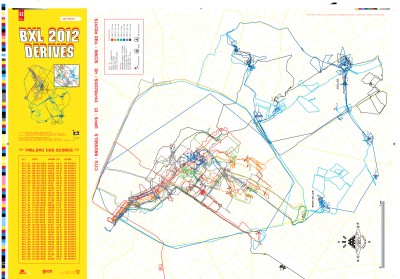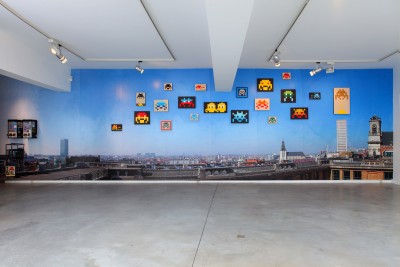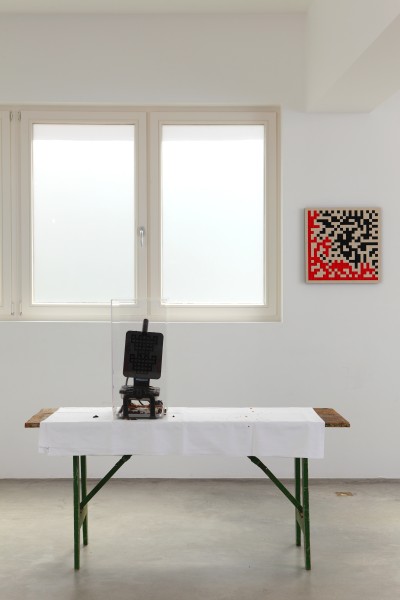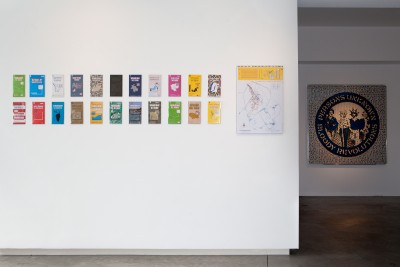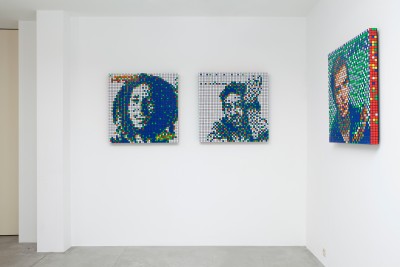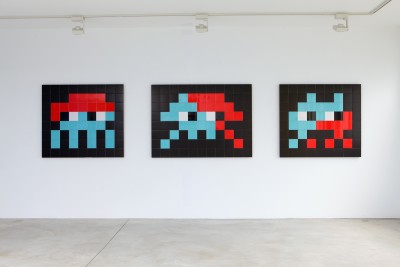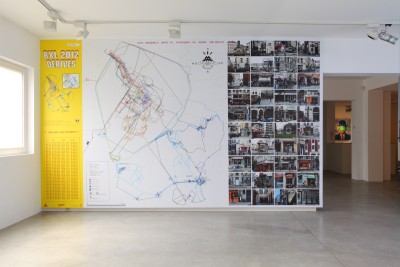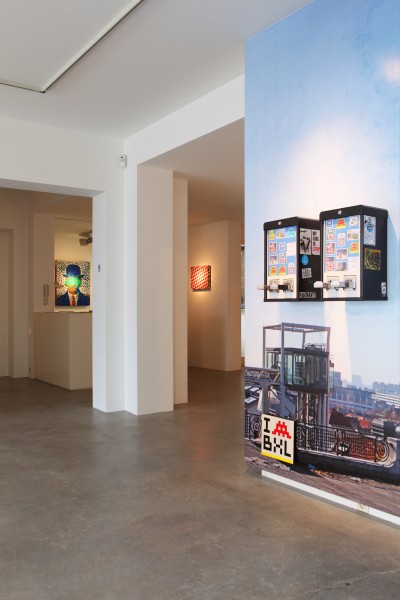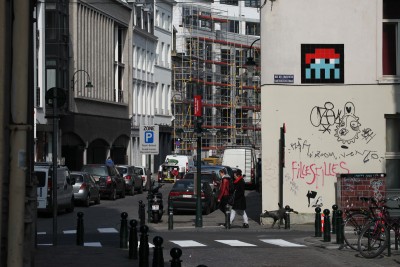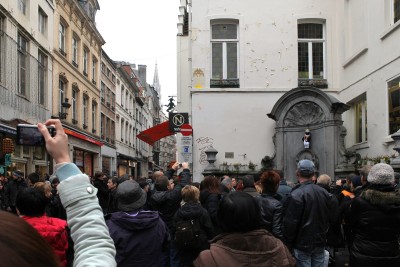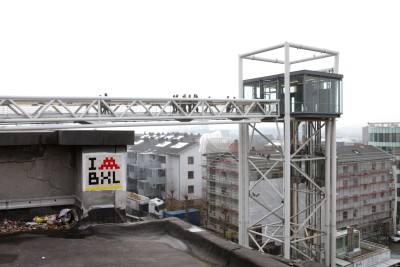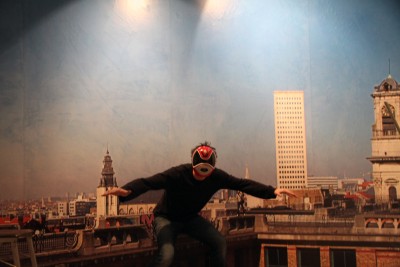Invader
BXL 2012 - Dérives
–
BXL 2012 - Sidetracks
For its 50th exhibition, ALICE Gallery has invited the French artist INVADER.
For the occasion, the artist has invaded the walls of Brussels with his mosaics, redrawing a map of the city according to his artistic wanderings.
In the gallery, Invader presents the aliases of the Brussels invasion (a unique piece for each street mosaic), installations of Rubik’s cubes and sculptures such as « The Speedball Machine »
INVADER
In 1996, the artist chooses the alias ‘Invader’ in reference to the game SPACE INVADERS (1978). Inspired by the famous 8-bit characters (such as Super Mario, Pac Man and Space Invaders) he creates thousands of different mosaics placed in various locations across the cities he visits.
At the beginning of the ‘naughties’, Internet helps promote street art to become the symbol of a new generation of artists that reinterpret the traditional approach to contemporary art, making it available to the greater public. Banksy, Sheperd Fairey and Invader become the most famous artists of the Street Art movement.
In 2011, Invader is rewarded for the E-reputation prize along with Damien Hirst and Sophie Calle. After analysis by Zen Reputation, he is considered as the most famous French artist on the web (excluding the Asian web). He reaches the 27th place in the world.
Facts and figures
1978 : The « Space invaders » video game is launched in Japan 1996 : Invader lands his first alien mosaic in Paris 1998 : Launch of the invasion in Paris 1999 : The invasion is extended to the rest of the world 2005 : Founding of the « Rubik Cubist » movement 1000 space invaders in Paris 19700 cumulative points earned in Paris 82 cities hit by the invasion 2732 space invaders in the world 5 public commissions 1 500 000 mosaic squares stuck to date 6 world tours 22 nights spent at the police station 17 solo exhibitions 42 group exhibitions 20 invasion maps edited 6 invasion guides edited
Articles
- « Le héros est de retour », Les Inrockuptibles, 8 juin 2011
- « Avec Invader, le street art prend de la hauteur », Libération, 13 juin 2011
- « Invader, sur la piste du pixel », M le magazine du Monde, 17 février 2012-03-23
- « The work plays upon the fine line between figure and ground, pattern recognition an dits camouflage. », ARTFORUM, janvier 2007.
The Invasion Goes On
The public space has always been a place for artists with distinct motivations and techniques. Amongst these contemporary artists, Invader has become a major figure on the international scene. Few artists have gained that level of worldwide recognition, especially outside of art institutions. The reason for this planetary success is a combination of the nature of his work and the evolution of our societies.
The backbone of Invader’s work is his Space Invader; a mosaic character inspired by famous 8-bit video games. He literally sticks them to the city walls; each character is a unique composition and of various size.
This source of inspiration creates a direct parallel between the recent history in digital imaging and advanced art. The use of mosaics reminds us of the obsolescence of low def images, a time where the pixel was nearly palpable. More importantly, Invader’s minimalist images evoke the infinite permutation of the digital image through the redistribution of a methodological coloured pixel in a grid. From four characters in the game Space Invaders, he can generate thousands of variations.
Playful and minimalist, the space invader stuck to the wall is a reference for the collective imagination. An empathetic link is created between the mosaics and the city they are in. To this date, the artist has invaded more than 80 cities throughout the world, connecting them through a web of space invaders; thereby contributing to the emergence of a global culture. His artistic expression becomes a militant act, working towards connecting different cultures in order to find a global solution to worldwide problems.
Invader has mastered the marketing techniques of multinationals to promote his art and world invasion. His unique ‘product’ is enhanced by an authentic approach, excellent visibility, clever merchandising, and has the support of a large community.
This aesthetic goes against the heritage of post-war modernism. Following the horrors of WWII, modernism sees the salvation of mankind through personal development achieved by the self-fulfilment of individuals as opposed to the progress of science. With this vision of modernism, also erected as a safeguard against Communist threat, makes the artist become part of an ‘avant-garde’ elitist group which the public only has access to through education and the recognition of the authority of art institutions.
The culture of popular mass production naturally represents the opposite of this modernism. From Marcel Duchamp’s ‘ready-made’ fountain in 1917 to Warhol’s silkscreen in the sixties, the end of the Western cultural model was clearly underway; inevitably, fine arts were converging towards pop and mass culture. Finally, the fall of the Berlin Wall in 1989 will sign the end of modernism.
The nineties saw a new generation of artists emerge, free from modernist anxieties, a generation that would skyrocket with the advent of the Internet by the beginning of the naughties.
A new aesthetic that embraces globalisation is born, a reaction to the rigidity of art institutions, it creates a new relationship between art and the greater public. Now independent from galleries, art institutions and the Art market, artists can interact directly with the world with through own means (Internet, work in the public space and merchandising. They transcend the boundaries between Fine Arts and applied arts, between high culture and subculture, what’s certain is that this movement isn’t done with shaking the very foundations of the Art world.
Invader’s art is playful in many ways: First in the very practice of his art, the artist discovers a city through a cat & mouse game with the local authorities. But also because his artwork is a game in itself; through his on-site and in-gallery mosaics, invasion maps, ready-made invaders, stickers… He invites the public to tag along and join him in his game, which takes place between streets, galleries, the Internet as well as from a city to a next. Invader has managed turned art into a collective game on a planetary level. Raphaël Cruyt
